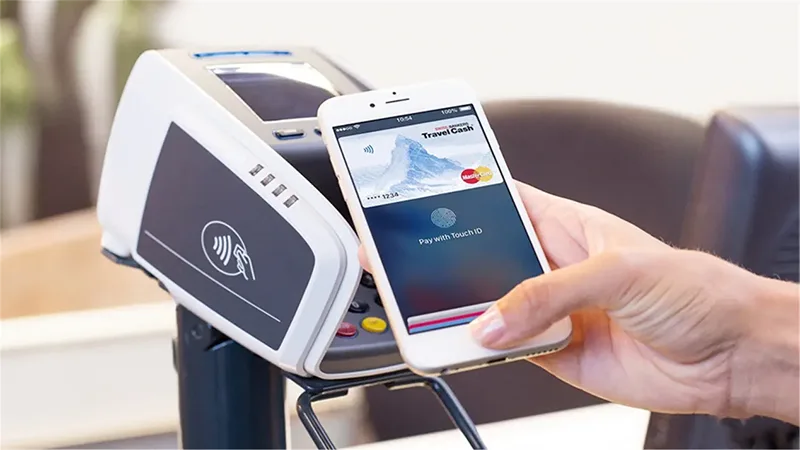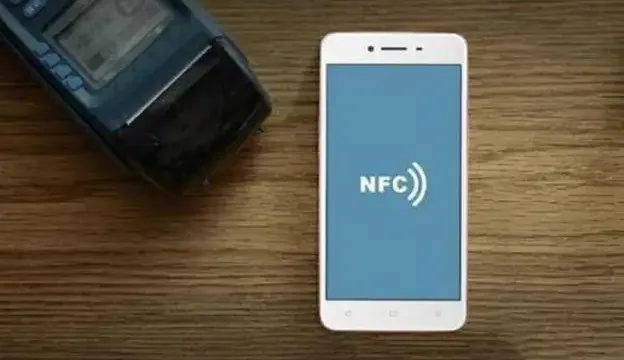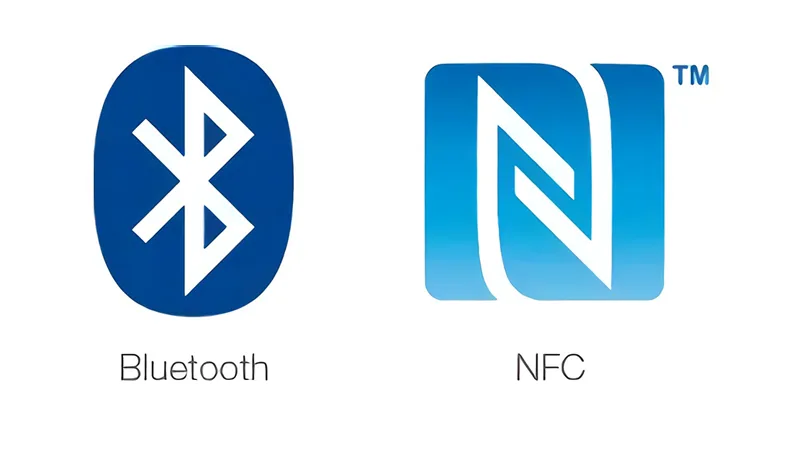Ngaran lengkep NFC nujul kana téhnologi Near Field Communication. Dumasar kana contactless Téknologi Idéntifikasi Frékuénsi Radio(RFID), Téknologi Near Field Communication nawiskeun cara komunikasi anu aman sareng gancang pikeun rupa-rupa barang éléktronik anu beuki populer dina kahirupan sapopoe..
1. Naon Téhnologi NFC?

The "deukeut widang" dina ngaran Cina tina téhnologi Radio Frequency Identification nangtung pikeun gelombang radio nu deukeut jeung médan éléktromagnétik.. Kanyataanna, gelombang radio sarua jeung gelombang éléktromagnétik jadi abides ku persamaan Maxwell. Éta hartina salila prosés transformasi tina anteneu pamancar ka anteneu narima, médan listrik jeung médan magnét bakal salawasna alternatip pikeun ngalaksanakeun bursa énergi. Jeung maranéhna bakal strengthened dina prosés bursa. Contona, Sinyal radio anu dianggo dina telepon sélulér urang disebarkeun sareng disebarkeun nganggo prinsip kerja ieu, sarta metoda ieu dingaranan Jauh-Lapang Komunikasi. Sareng dina sapuluh panjang gelombang gelombang éléktromagnétik, éléktrik ogé médan magnét dipisahkeun ti unggal lianna. Lajeng médan listrik dina waktu ieu teu boga loba significance. Sanajan kitu, médan magnét bisa dimangpaatkeun pikeun komunikasi jarak pondok, sarta kami nelepon deui Near Field Communications.
Digabungkeun jeung duananakomunikasi deukeut-sawah téhnologi jeung téhnologi komunikasi mobile, jasa komunikasi Near Field bisa minuhan rupa-rupa kalungguhan kaasup pembayaran éléktronik, auténtikasi identitas, Bagian Tikét, konvérsi data, anti-pemalsuan ogé iklan. Ku kituna, éta mecenghul jenis peran dina industri komunikasi mobile. Ladenan Near Field Communication ningkatkeun kalungguhan telepon sélulér, nu ngarobah kabiasaan pamayaran pamaké pikeun jadi beuki dipindahkeun kana prosés éléktronifikasi, sahingga nyetel jenis anyar mode bisnis konsumsi konsumen.
2. Kumaha NFC(Deukeut Bidang Komunikasi) Gawe?

Téknologi Komunikasi Near Field sanggup nyetél étajaringan nirkabel sacara gancang sareng otomatis, nawiskeun "sambungan virtual" kanggo sélular, Alat Bluetooth atanapi WIFI pikeun ngawujudkeun komunikasi diantara aranjeunna dina jarak anu pondok, kitu ogé sahingga cocog pikeun komunikasi diantara alat nu bagerak, éléktronika konsumén, komputer pribadi jeung komponén dikawasa pinter.
Komunikasi téknologi Komunikasi Near Field lumangsung antara alat initiating jeung alat target, sareng naon waé alat NFC tiasa janten alat ngamimitian atanapi alat target. Dua alat ieu gandeng ku hiji médan magnét arus bolak-balik sarta hiji alat ngirimkeun sinyal digital dina cara modulasi pamawa dina mode ASK atawa mode FSK.. Alat anu digagas nyiptakeun médan magnét frekuensi radio pikeun diluncurkeun (skéma modulasi, encoding, speed transmisi na pigura format panganteur Radio Frékuénsi) Samentawis alat target ngabales paréntah anu diprakarsai ku alat anu digagas sareng pilih médan magnét frekuensi radio anu diprakarsai ku alat anu digagas atanapi didamel ku nyalira pikeun ngahontal komunikasi..
3. Kasus aplikasi téknologi NFC

Aplikasi tina model kartu
Jinis modél tiasa dianggo pikeun pamayaran sélulér tanpa kontak kalebet mall balanja, sarana angkutan jeung aplikasi sejenna. Pangguna ngan saukur nempatkeun telepon caket sareng pamiarsa kartu teras pangguna ngan saukur ngalebetkeun kecap konci pikeun mastikeun transaksi atanapi ngumpulkeun langsung.. Conto ngalibatkeun kontrol aksés, tiket beus, tikét, jsb. Kartu didorong ku pamaca kartu sareng tiasa dianggo leres upami alat anu mawa kartu dijalankeun dina kakuatan..
Aplikasi panyalindungan kaamanan
Aplikasi téknologi Near Field Communication dina panyalindungan kaamanan utamana ngarobah telepon sélulér pikeun ngakses kartu, tiket éléktronik jeung saterusna.
Kartu aksés virtual anu dilengkepan ku téknologi Near Field Communication ngarujuk kana tulisan data kartu aksés anu aya kana téknologi Near Field Communication telepon.. Ku kituna, ku ngan ngagunakeun telepon sélulér, Anjeun tiasa ngawujudkeun jasa kontrol aksés tanpa kartu pinter ku kituna teu ukur bisa ngahontal genah tina konfigurasi, ngawaskeun sareng modifikasi kontrol anu tiasa diaksés tapi ogé ngahontal modifikasi jauh sareng konfigurasi kalebet distribusi samentawis kartu kredensial nalika diperyogikeun.. Tikét éléktronik virtual anu dilengkepan téknologi Komunikasi Near Field utamana diterapkeun dina cara anu saatos pangguna mésér tikét., sistem tikét bakal mindahkeun inpormasi tikét ka telepon sélulérna. Telepon sélulér anu dilengkepan fungsi NFC tiasa ngarobih inpormasi tikét virtual janten tikét éléktronik. Nalika mariksa tikét, Anjeun tiasa langsung gesek telepon pikeun genah.
Aplikasi téknologi Near Field Communication dina transportasi
Transportasi bisa disebutkeun fungsi paling dasar tina aplikasi téhnologi Near Field Communication. Ku cara noel sungut gerbang wewengkon bacaan kartu jeung alat NFC, anjeun tiasa otomatis muka gerbang, nu fungsi tina kartu lalulintas kota terpadu kana alat NFC on luhureun simulasi kartu pikeun ngahontal fungsi. Dina kasus nu sabenerna, sanajan kartu transportasi Shenzhen dina sél domestik dilengkepan téhnologi 2.4G, ngajadikeun bédana badag tina téhnologi NFC dina hal palaksanaan teknis na tapi cara utilization sarua. Téknologi Near Field Communication malah tiasa maénkeun peran anu penting dina lingkungan pamayaran mikro subway sareng beus.
4. The Ssolusi pikeun téknologi Komunikasi Near Field

NFC ngarujuk kana standar anu diciptakeun babarengan ku Nokia, Philips, jeung Sony, sarta geus standarisasi dina ISO 18092, ECMA 340, jeung ETSI TS 102 190. Naon deui, Éta cocog sareng ISO anu diterapkeun sacara universal 14443 Tipe-A, B, sarta Felica baku non-kontak infrastruktur kartu calakan. Standar komunikasi jarak deukeut nangtukeun skéma modulasi, coding, speed pangiriman jeung format pigura tina interfaces Radio Frékuénsi pikeun alat-alat Komunikasi Near Field, kitu ogé skéma inisialisasi sareng kaayaan anu dipikabutuh pikeun kontrol konflik data dina inisialisasi modél Komunikasi Near Field aktif sareng pasif.. Naon deui, eta ngahartikeun protokol mindahkeun ngawengku inisiasi protokol jeung sarana konversi data.
Tilu modeu operasi dirojong pikeun Near Field Communication Services.
Modél simulasi kartu
- Stasion sélulér tiasa disimulasikeun salaku kartu non-contactless normal sapertos pamayaran sélulér, tikét mobile, pangakuan identitas jeung saterusna.
- Conto aplikasi: Stasion sélulér non-contactless tiasa disimulasi salaku kartu bank, kartu aksés, tiket éléktronik jeung saterusna. Lajeng stasiun mobile non-contactless berinteraksi sareng sagala terminal séjén.
Modél pamaca
- Stasion sélulér tiasa maca eusi dina kartu tanpa kontak atanapi tag non-kontak sapertos téténggér virtual., iklan jeung sajabana.
- Kasus aplikasi: poster éléktronik, dimana stasiun mobile contactless berinteraksi sareng modul contactless dipasang dina poster, jeung stasiun mobile aktip maca data pakait dina kartu atawa tag.
Modeu komunikasi peer-to-peer
Dua stasiun sélulér tiasa nransferkeun data langsung ka silih dina jarak anu caket, sapertos nyingkronkeun jadwal, jeung kaulinan, ogé babagi eusi dikirimkeun, jsb.
Kasus aplikasi: Dua stasiun sélulér tanpa kontak tiasa nransferkeun atanapi nyinkronkeun data saling, saperti gambar, musik, nada dering, jsb.
Kaunggulan jeung drawbacks tina téhnologi Komunikasi Near Field

Kaunggulan sareng kalemahan téknologi Komunikasi Near Field
- Kakuatan: Dibandingkeun sareng pembayaran komunikasi jarak tradisional, pembayaran téhnologi Near Field Communication boga mangpaat kaamanan tinggi, setelan sambungan gancang, jsb. Anjeun tiasa make pangmayaran dina jarak kirang ti 10 cm, nu bisa nyingkahan silih gangguan antara alat. Naon deui, waktos setelan sambungan na kirang ti 0.1 detik, nu greatly ensures kaamanan pangmayaran pamaké. oge, éta langkung mirah.
- Kakurangan: popularitas NFC merlukeun rojongan ti angka nu gede ngarupakeun alat hardware, sareng panyebaran sajumlah ageung alat parangkat keras ku produsén telepon sélulér sareng lembaga keuangan didasarkeun kana pasar anu cukup ageung.. Salaku tambahan, padika pembayaran ieu ogé nyanghareupan masalah. Salaku conto, nu standar bakal dipaké, naon anu kudu dipigawé lamun telepon pamaké leungit, jeung kumaha carana nyetel jumlah pamayaran.
Ayeuna, téhnologi kode dua diménsi beuki populér ogé dina aplikasi lega tur dina béaya rendah. Salami anjeun gaduh smartphone, Anjeun tiasa maca inpormasi anu relevan tina kode dua diménsi. Sanajan kitu, disadvantage téh nya éta ngan bisa maca informasi dina hiji arah kalawan speed bacaan slow. Salaku tambahan, merlukeun scanning akurat ti scanner teh, sareng peryogi lokasi pamaca anu luhur supados pangaruh scanning moal saé upami mesin disimpen dina tempat anu rame. Salaku conto, Butuh waktu lila pikeun nyeken kode QR. Sabalikna, kalawan fitur speed maca gancang, jeung sarat low pikeun lokasi bacaan, téhnologi Komunikasi Near Field ogé cocog pikeun tempat kalawan loba lalulintas. oge, teu ngan bisa maca tapi ogé ngawujudkeun interaksi informasi dua arah.
Kaamanan téknologi NFC

Téknologi nirkabel jarak deukeut tina Near Field Communication gaduh fitur gancang, gampang dianggo sareng aman, anu kaamanan mangrupikeun fitur anu paling penting dina industri pamayaran.
Perlu dipikanyaho yén inpormasi akun kartu bank belang magnét tradisional disimpen dina jalur magnét. Nalika kartu bank dipaké pikeun ngahontal transaksi, mesin POS bakal tiasa transact jumlah, inpormasi akun kartu bank sareng kecap akses akun anu diasupkeun ku pangguna. Teras sadaya inpormasi anu ditransaksikeun bakal dikirimkeun ka server bank pikeun ngahontal verifikasi. Nalika verifikasi lulus, bank back-end ngalengkepan deduksi, sarta tungtungna mulih hasil urus.
Alatan gampang dibaca sareng sifat statik tina belang magnét, gampang disalin langsung, nu ngabalukarkeun nyieun dua kartu kalawan informasi akun idéntik, ku kituna kartu pamaké ieu swiped ku batur sanajan tanpa kartu ninggalkeun samping nya.
Nalika nganggo téknologi NFC, Chip Komunikasi Near Field ngamungkinkeun auténtikasi dua arah dinamis sareng POS. Data pikeun unggal transaksi kasebar sareng inpormasi akun disimpen ngalangkungan enkripsi sareng henteu tiasa dibaca langsung. Ieu ngaréspon sababaraha masalah.
- Inpormasi dina komunikasi lapangan anu caket henteu disimpen dasar sareng teu tiasa disalin ku cracker ku cara maca langsung.
- Kéngingkeun inpormasi akun butuh auténtikasi dua arah sareng pos. Alat anu teu sah teu gaduh konci oténtikasi ieu, Kituna teu tiasa kéngingkeun inpormasi akun.
- Unggal transaksi didamel ku generator nomer acak dina chip komunikasi anu caket pikeun ngahasilkeun konci samentawis. Data komunikasi sah pikeun waktos éta janten upami caket data interaksi komunikasi tiasa direbut, Éta henteu tiasa nyalin transaksi. Ogé teu mungkin mun saukur tamper kalawan jumlah forge urus a
Salaku hasilna, Kaamanan Komunikasi Near Field henteu aya dina halimunan data transaksi tapi kanyataan yén NFC mawa énergi kana kartu pinter., ngamungkinkeun sakabéh prosés transaksi dihasilkeun dinamis ogé sahingga teu mungkin pikeun nyalin kartu bank ku saukur maca eta, sahingga pamustunganana achieving kaamanan.
Di dieu nyandak conto prosés auténtikasi Mifare pikeun masihan katerangan salajengna:
- Kartu Mifare B ngirimkeun angka Rb acak;
- Pamaca A ngahasilkeun angka acak Ra na encrypts Rb babarengan jeung mulih Token AB kana kartu;
- Saatos kartu narima TokenAB, decode eta tur pariksa yen angka acak Rb dina ToakeAB sarua jeung nu di hambalan 1. Auténtikasi gagal lamun teu sarua.
- Token BA; Kartu B encrypts Ra ngan dikirim sarta mindahkeun ka nu maca hiji nilai TokenBA.
- Saatos maca A narima eta, eta decodes na verifies lamun jumlah acak dina TokenBA sarua jeung hiji di Ra di hambalan 2. Upami sami, auténtikasi dua arah suksés.
Nalika kartu jeung maca boga konci idéntik, aranjeunna tiasa lulus auténtikasi dumasar kana lima tahapan di luhur. Koncina henteu dikirimkeun dina téks anu jelas salami prosés auténtikasi sahingga kaamananna ningkat pisan.
Inpormasi anu disebatkeun di luhur ngécéskeun kaamanan kartu Near Field Communication ngan tina sudut pandang salinan kartu. Sandi pangguna ngan ukur diperyogikeun pikeun mastikeun kaamanan transaksi salami prosés pamayaran.
7. NFC VS Bluetooth

NFC, kalayan nami lengkep Inggris tina Near Field Communication, umumna katelah téknologi komunikasi lapangan caket. Sakumaha dipikawanoh ku ngaran, éta produk komunikasi jarak deukeut jeung téknologi nirkabel nu diprakarsai ku Philips tur dikembangkeun babarengan ku Nokia, Sony jeung loba pausahaan séjén ogé pabrik.
Bluetooth nyaéta standar pikeun téknologi komunikasi data nirkabel jarak jauh. Éta sanggup data nirkabel sareng multi-titik tunggal sareng pangiriman sora dina jarak radius 10 méter sareng bandwidth pangiriman data dugi ka 1Mbps.. Média komunikasi ngarujuk kana gelombang éléktromagnétik kalayan frékuénsi antara 2.402GHz sareng 2.480GHz..
8. NFC VS RFID

Beda antara Idéntifikasi Frékuénsi Radio sareng Komunikasi Lapangan Deukeut:
- Frékuénsi operasi: Idéntifikasi Frékuénsi Radio ngagaduhan tilu frékuénsi operasi, nu frékuénsi low, frékuénsi luhur (13.56MHz), sarta Frékuénsi Ultra High. The Near Field Communication ngan boga hiji frékuénsi operasi, nu nujul kana 13.56MHZ.
- Jarak operasi: Duanana nyaéta téknologi komunikasi nirkabel jarak pondok tapi Idéntifikasi Frekuensi Radio kalebet tilu frekuensi operasi, jeung jarak gawé sababaraha séntiméter ka puluhan méter. Sacara téoritis, jarak gawe Near Field Communication nyaeta mimitian ti 0 ka 20 cm. Sanajan kitu, paling item Near Field Communication ngagunakeun téknologi suprési kakuatan husus, nu ngakibatkeun jarak operasi maranéhanana ngan mimitian ti 0 ka 10 cm.
- Modél Operasi: Pamaca sareng kartu non-kontak dina Idéntifikasi Frékuénsi Radio henteu gumantung unggal anu sanés sahingga henteu tiasa gentos modél. Dina waktos anu sasarengan, Near Field Communication tiasa ngadukung modél maca sareng nyerat sareng mode kartu tapi ogé ngagentos modél operasi.
- Komunikasi Peer-to-Peer: Idéntifikasi Frékuénsi Radio henteu tiasa ngadukung komunikasi peer-to-peer. Sanajan kitu, éta tiasa nyetél komunikasi peer-to-peer antara alat Bluetooth anu béda sacara gancang. oge, téhnologi Near Field Communication bisa ngahontal komunikasi peer-to-peer.
- Protokol standar: Protokol komunikasi dasar tina Near Field Communication tiasa sapinuhna cocog sareng protokol Idéntifikasi Frekuensi Radio. Ku kituna, Téknologi Komunikasi Near Field ogé tiasa diterapkeun dina widang aplikasi Idéntifikasi Frekuensi Radio Frekuensi Tinggi.
- Widang aplikasi: Kusabab kasaluyuan téknologi Komunikasi Near Field sareng Idéntifikasi Frékuénsi Radio Frékuénsi Luhur, Téknologi Komunikasi Near Field tiasa dianggo sacara lega. Kalayan seueur standar sareng pajeulitna, Idéntifikasi Frékuénsi Radio tiasa ngagunakeun standar téknis anu cocog dina widang khusus atanapi industri anu ngagaduhan syarat khusus.
9. NFC VS WiFabdi

NFC nangtung pikeun Near Field Communication, atanapi Near Field Communication téhnologi. Diciptakeun babarengan ku Philips sareng Sony, NFC mangrupikeun téknologi anu diidentifikasi sareng dihubungkeun tanpa kontak anu ngamungkinkeun Komunikasi Lapangan Deukeut dihontal antara dua alat sélulér, éléktronika pamaké, Komputer pribadi sareng alat kontrol calakan. Téknologi Near Field Communication nawiskeun rencana anu sederhana sareng dumasar kana sentuhan anu ngamungkinkeun para pangguna ngobrolkeun inpormasi sareng ngaksés eusi ogé jasa anu béda dina cara anu sederhana sareng intuitif..
Wifi nujul kana téknologi anu ngamungkinkeun terminal kaasup komputer pribadi sareng alat genggam(misalna., PDAs, telepon sélulér), disambungkeun ka silih dina metoda nirkabel. Wi-Fi nangtung pikeun nami merek pikeun téknologi komunikasi jaringan nirkabel, nu dipiboga ku WiFi Alliance. Tujuanana nyaéta pikeun ningkatkeun interkonektipitas antara item jaringan nirkabel numutkeun IEEE 802.11 standar. Ayeuna, jalma umumna nyampur Wi-Fi sareng IEEE 802.11 komo nganggap yén Wi-Fi sami sareng Internét nirkabel..
10. The Sajarah ngembangkeun téhnologi Near Field Communications

Philips Semiconductor sareng Sony badé ngembangkeun téknologi komunikasi nirkabel anu cocog sareng téknologi kartu tanpa kontak 2003. Philips ngirimkeun tim anggota ka Jepang pikeun gawé bareng jeung insinyur ti Sony pikeun 3 bulan, teras babarengan ngaluncurkeun téknologi komunikasi nirkabel anu cocog sareng perjanjian kartu non-kontak ISO14443 anu aya., nu disebut NFC (Deukeut Bidang Komunikasi).
Spésifikasi netepkeun metode komunikasi nirkabel antara dua alat Komunikasi Near Field dumasar kana 13.56 frékuénsi MHz. Lamun ngobrol ngeunaan Near Field Communication, teu aya nu maca, euweuh kartu tapi ngan alat Komunikasi Near Field. spésifikasi nangtukeun dua model komunikasi antara alat Near Field Communications: modeu aktip jeung mode pasip. Naon deui, eta ngahartikeun pilihan tina dua model jeung Radio Frékuénsi widang métode anti tabrakan, métode anti tabrakan parabot, ogé nangtukeun béda laju komunikasi laju baud tina métode coding, metode modulasi dan demodulasi serta metode komunikasi dan protokol lainnya. Pikeun nempatkeun eta basajan, fungsi téhnologi salaku ngarengsekeun masalah kumaha nukeur aliran data.
Spésifikasi ahirna dikirimkeun ka organisasi standar ISO sareng organisasi disatujuan salaku standar internasional resmi, nu disebut ISO18092. Sareng engkéna éta cocog sareng ISO15693 pikeun ngembangkeun standar global Near Field Communication anyar IP2 anu ngarujuk kana ISO. 21481. Samentara éta, ECMA éta (Asosiasi Pabrikan Komputer Éropa) ogé promulgated standar pikeun Near Field Communication, anu kalebet Ecora340 sareng ECMA352. Sareng standar anu cocog sareng ISO18092[2] sareng ISO21481. Kanyataanna, eusi 2 standar anu sami sareng ECMA henteu dieusi, sareng ogé tiasa diunduh tina Internét. Sanajan kitu, Standar ISO kedah dieusi. Kabeneran, Pikeun ngamajukeun standarisasi, boh iso / iec 18092:2013 ogé iso / iec 21481:2012 versi sayogi pikeun diunduh éléktronik non-majaluan halaman perusahaan standar internasional resmi.
Supaya ngagancangkeun tumuwuh industri komunikasi anu caket, Philips, Sony sareng Nokia bareng ngagagaskeun setélan komunikasi anu caket, anu ditujukeun pikeun ngamajukeun kamekaran aplikasi industri sareng masihan definisi kana spésifikasi lapisan sedeng anu aya hubunganana pikeun aplikasi berbasis Near Field Communication sapertos sababaraha protokol komunikasi konversi data NDEF ogé sababaraha spésifikasi tag Near Field Communication dumasar kana tag non-kontak.. Anu terakhir utamina kalibet dina harti struktur data internal kartu sareng kumaha ngakuan tag anu cocog sareng Forum Komunikasi Near Field standar., kumaha diversify data dilarapkeun husus sarta spésifikasi séjén nu patali. Tujuanana nyaéta pikeun ngaktipkeun interkonéksi antara alat NFC anu béda. Contona, kumaha ponsel has bisa ngarobah data, kumaha ngakuan poster éléktronik idéntik, jsb.



















